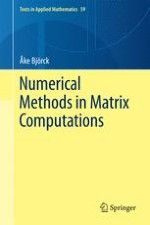
2015 | OriginalPaper | Buchkapitel
1. Direct Methods for Linear Systems
verfasst von : Åke Björck
Erschienen in: Numerical Methods in Matrix Computations
Aktivieren Sie unsere intelligente Suche, um passende Fachinhalte oder Patente zu finden.
Wählen Sie Textabschnitte aus um mit Künstlicher Intelligenz passenden Patente zu finden. powered by
Markieren Sie Textabschnitte, um KI-gestützt weitere passende Inhalte zu finden. powered by
Abstract
By a matrix we mean a rectangular array of real or complex numbers ordered in \(m\) rows and \(n\) columns: